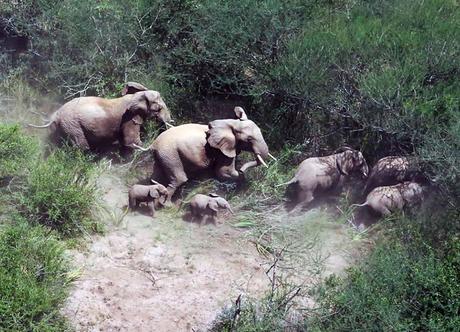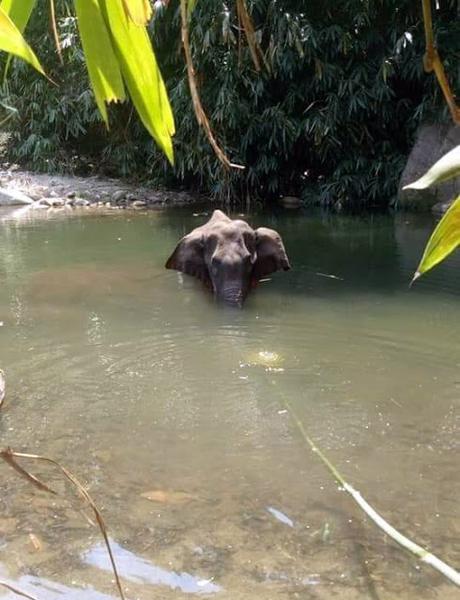Cruelty is pleasure in inflicting suffering or inaction towards another's suffering when a clear remedy is readily available. Cruel ways of inflicting suffering may involve violence, but affirmative violence is not necessary for an act to be cruel. For example, if a person is drowning and begging for help and another person is able to help with no cost or risk, but is merely watching with disinterest or perhaps mischievous amusement, that person is being cruel—rather than violent. Our hearts cry on seeing an elephant standing in water – as stated above, one need not rush to get it out of water but just stand with heads down in utter shame for it was mankind’s cruelty that made this gentle giant stand in water and die with suffering.Man is the most cruel animal and perhaps only Hammurabi Code should be searched upon to give proper punishment to its perpetrator.
The media often portrays African countries as poor, strife-torn, lawless suffering States.In Ethiopia, ethnic tensions and violence are on the rise. Ethnic conflicts are not new, but the levels of violence being witnessed today are very disturbing.
 This is no post on human
conflicts but humans killing others and animals. Poachers have killed at least
six elephants in a single day in Ethiopia, wildlife officials said on Tuesday,
the largest such slaughter in memory in the east African nation. The elephants
died last week, when they ventured out of the Mago National Park in the far
south of Ethiopia to drink water, Ganabul Bulmi, the park’s chief warden, told
reporters. “The poachers then removed all the tusks from the elephants. It was
a mass killing. We haven’t seen anything like this before,” he said. Two other
elephants might have been killed the same day, and an investigation continues.
According to wildlife
officials, Ethiopia had more than 10,000 elephants in the 1970s but poaching
and habitat degradation have reduced the number to about 2,500 to 3,000 in
recent years. Officials suspect that most elephant tusks and finished products
are slipped out of the country to China and south-east Asian countries. In
2015, Ethiopian officials burned 6.1 tonnes of illegal elephant tusks, ivory
trinkets, carvings and various forms of jewelry to discourage poaching and
the ivory trade. Across Africa, the Covid-19 pandemic has provided
opportunities for poachers, with security forces diverted to other tasks.
Combined with the absence of visitors, this has left many reserves vulnerable.
Even
poachers can be spared but not these ruthless criminals of Kerala – the gentleness
displayed by the poor elephant makes us cry and leave us dumb. The female
elephant which reportedly was pregnant elephant in unbearable pain, did not
harm anybody, did not crush any objects, but walked to the Velliyar River, and stood with
her mouth and trunk in the water. She probably felt this would give her some
relief, and alas passed away a cruel death.
Article 51-A (g) of the
Indian Constitution says that it shall be duty of every citizen of India to
have compassion for living creatures. The pregnant elephant in pic was killed
in human- wildlife conflict. But where lies our duty? N humanity?? – asks the
tweet of Kerala Forest Dept.The State
has no answer.
Malappuram is the first municipality in the district formed in
1969. Malappuram is situated 54 km
southeast of Calicut and 90 km northwest of Palakkad. Its people committed the
most abhorrent crime.News reports state
that an elephant that was pregnant died
in Kerala, standing in water, last Wednesday, after she faced one of the most
brutal forms of animal abuse. She ate a pineapple filled with firecracker,
allegedly placed by some locals. The fruit exploded in her mouth, leading to
the inevitable tragedy. The incident came to light after a forest officer
narrated the details of the horrific death on social media.
The wild elephant had left
the forests of Silent Valley in Palakkad district, meandering into a nearby
village in search of food. Pineapples with country-made crackers had been used
by locals to protect their fields against wild boars. According to forest officials, the elephant is
suspected to have eaten a pineapple. The elephant walked around in the village,
in searing pain and in hunger. "She trusted everyone. When the pineapple
she ate exploded, she must have been shocked not thinking about herself, but
about the child she was going to give birth to in 18 to 20 months," forest
officer Mohan Krishnan, who was part of the Rapid Response Team to rescue the
elephant, wrote on Facebook.
This is no post on human
conflicts but humans killing others and animals. Poachers have killed at least
six elephants in a single day in Ethiopia, wildlife officials said on Tuesday,
the largest such slaughter in memory in the east African nation. The elephants
died last week, when they ventured out of the Mago National Park in the far
south of Ethiopia to drink water, Ganabul Bulmi, the park’s chief warden, told
reporters. “The poachers then removed all the tusks from the elephants. It was
a mass killing. We haven’t seen anything like this before,” he said. Two other
elephants might have been killed the same day, and an investigation continues.
According to wildlife
officials, Ethiopia had more than 10,000 elephants in the 1970s but poaching
and habitat degradation have reduced the number to about 2,500 to 3,000 in
recent years. Officials suspect that most elephant tusks and finished products
are slipped out of the country to China and south-east Asian countries. In
2015, Ethiopian officials burned 6.1 tonnes of illegal elephant tusks, ivory
trinkets, carvings and various forms of jewelry to discourage poaching and
the ivory trade. Across Africa, the Covid-19 pandemic has provided
opportunities for poachers, with security forces diverted to other tasks.
Combined with the absence of visitors, this has left many reserves vulnerable.
Even
poachers can be spared but not these ruthless criminals of Kerala – the gentleness
displayed by the poor elephant makes us cry and leave us dumb. The female
elephant which reportedly was pregnant elephant in unbearable pain, did not
harm anybody, did not crush any objects, but walked to the Velliyar River, and stood with
her mouth and trunk in the water. She probably felt this would give her some
relief, and alas passed away a cruel death.
Article 51-A (g) of the
Indian Constitution says that it shall be duty of every citizen of India to
have compassion for living creatures. The pregnant elephant in pic was killed
in human- wildlife conflict. But where lies our duty? N humanity?? – asks the
tweet of Kerala Forest Dept.The State
has no answer.
Malappuram is the first municipality in the district formed in
1969. Malappuram is situated 54 km
southeast of Calicut and 90 km northwest of Palakkad. Its people committed the
most abhorrent crime.News reports state
that an elephant that was pregnant died
in Kerala, standing in water, last Wednesday, after she faced one of the most
brutal forms of animal abuse. She ate a pineapple filled with firecracker,
allegedly placed by some locals. The fruit exploded in her mouth, leading to
the inevitable tragedy. The incident came to light after a forest officer
narrated the details of the horrific death on social media.
The wild elephant had left
the forests of Silent Valley in Palakkad district, meandering into a nearby
village in search of food. Pineapples with country-made crackers had been used
by locals to protect their fields against wild boars. According to forest officials, the elephant is
suspected to have eaten a pineapple. The elephant walked around in the village,
in searing pain and in hunger. "She trusted everyone. When the pineapple
she ate exploded, she must have been shocked not thinking about herself, but
about the child she was going to give birth to in 18 to 20 months," forest
officer Mohan Krishnan, who was part of the Rapid Response Team to rescue the
elephant, wrote on Facebook.
 So powerful was the
cracker explosion in her mouth that her tongue and mouth were badly injured.
The elephant walked around in the village, in searing pain and in hunger. She
was unable to eat anything because of her injuries. "She didn't harm a
single human being even when she ran in searing pain in the streets of the
village. She didn't crush a single home. This is why I said, she is full of
goodness," Mr Krishnan wrote in an emotional note in Malayalam, along with
photos of the elephant.
The elephant eventually
walked up to the Velliyar River and stood there. Photos showed the elephant
standing in the river with her mouth and trunk in water, perhaps for some
relief from the unbearable pain. The forest officer said she must have done
this to avoid flies and other insects on her injuries. The forest officials
brought two captive elephants, Surendran andNeelakanthan, to lead her out of the river. "But I think she had a
sixth sense. She didn't let us do anything," Mohan Krishnan wrote. After
hours of attempts by the officials to rescue the elephant, she died at 4 pm on
May 27, standing in water.
Killing an elephant after
badly injuring her tongue and mouth – how barbaric humans are !The elephant was taken back inside the forest
in a truck, where the forest officials cremated her.Mankind needs to bow for the cruelty
afflicted on her.Please forgive us for the
cruelty .. ..
With profound grief
S. Sampathkumar
3.6.2020
So powerful was the
cracker explosion in her mouth that her tongue and mouth were badly injured.
The elephant walked around in the village, in searing pain and in hunger. She
was unable to eat anything because of her injuries. "She didn't harm a
single human being even when she ran in searing pain in the streets of the
village. She didn't crush a single home. This is why I said, she is full of
goodness," Mr Krishnan wrote in an emotional note in Malayalam, along with
photos of the elephant.
The elephant eventually
walked up to the Velliyar River and stood there. Photos showed the elephant
standing in the river with her mouth and trunk in water, perhaps for some
relief from the unbearable pain. The forest officer said she must have done
this to avoid flies and other insects on her injuries. The forest officials
brought two captive elephants, Surendran andNeelakanthan, to lead her out of the river. "But I think she had a
sixth sense. She didn't let us do anything," Mohan Krishnan wrote. After
hours of attempts by the officials to rescue the elephant, she died at 4 pm on
May 27, standing in water.
Killing an elephant after
badly injuring her tongue and mouth – how barbaric humans are !The elephant was taken back inside the forest
in a truck, where the forest officials cremated her.Mankind needs to bow for the cruelty
afflicted on her.Please forgive us for the
cruelty .. ..
With profound grief
S. Sampathkumar
3.6.2020

